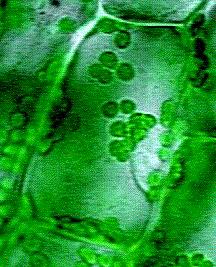



Plantae: More on Morphology
CLICK HERE FOR A TABLE comparing the gametophytes and sporophytes of the
major extant divisions. The table is linked to each of the divisions pictured.





Like other eukaryotes, plants have a nucleus, plasma membrane, mitochondria, and other organelles, but plant cells differ from animal, fungal, and protist cells in a number of important ways. The most obvious difference is the presence of a cell wall which surrounds each cell. It is composed primarily of cellulose, a complex carbohydrate made from glucose. Cellulose provides structural support while remaining flexible; flower petals, for instance, are flexible but will snap if folded too far.
When plant cells divide, they must form a new cell wall between them, and this is accomplished by the formation of a phragmoplast, a system of microtubules oriented along the axis of cell division which helps to guide the deposition of cellulose. This is also an important difference from the "green algae", which produce a phycoplast during mitosis, in which the microtubules lie perpendicular to the axis of division. Only plants and charophytes divide their cells with the aid of a phragmoplast.
Neighboring cells in plants are connected across their cell walls by extensions of the cells through pores called plasmodesmata. A plasmodesma allows cells to transfer nutrients, water, and some other diffusible materials without having to pass them across membranes or other barriers. They are also important for understanding how diseases spread through the tissues of a plant.
At maturity, most plant cells are filled with a single large vacuole, such that the nucleus, plastids, and other organelles are all close to the cell membrane. This can be seen in the picture at right. At the far right is the nearly transparent nucleus, and clusters of plastids can be seen toward the bottom and left. Those plastids which appear to be in the "middle" of the cell are actually at the periphery; remember that there is a cell wall toward you, and a wall on the far side of the cell, with the vacuole filling most of the space in between.
The vacuole is a membrane-bound bag of fluid, containing ions, stored nutrients, and waste materials. The storage of waste materials is a very important function of the vacuole, since plants cannot excrete their wastes the way animals do. The vacuole also assists the cell in maintaining turgor pressure. The high concentration of materials in the vacuole causes water to diffuse into the cell, increasing its volume. Because of the cell wall, however, the amount of space into which the cell can expand is limited. The cell thus exerts outward pressure on its cell wall, and when all cells are maintaining this pressure, the plant gains rigidity. You can notice this by comparing crisp fresh celery with celery that has sat around and grown limp. The old celery has lost fluids, and is no longer rigid.
Plastids are perhaps the most important feature of plants, that is, from the perspective of animals that live on land. The plastid is an organelle which contains chlorophyll. The chlorophyll captures the energy of light, and makes it accessible to the plant for photosynthesis. This provides the energy plants use to manufacture sugars, which are then used as a fuel source for continued growth. The sugars are often linked together for easy storage into a complex carbohydrate called starch. Without these sugars and starch, life on land as we know it would be impossible, for there would be practically no food -- no grains, no fruits, no vegetables. Another useful by-product of photosynthesis is oxygen, though plants are not the most important producers of this gas. Most of our oxygen comes from phytoplankton in the earth's oceans.


